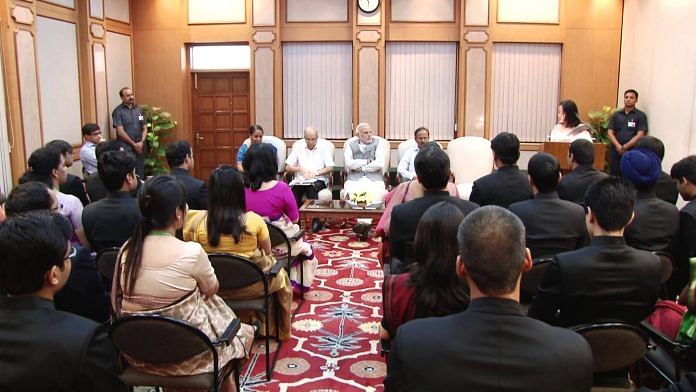New Delhi: The insufficient strength of India’s diplomatic corps has always been a recurring topic of discussion in media and policy circles.
A shortage of diplomats not only hinders the realisation of foreign policy goals, but also affects India’s global outreach. This is why the BJP’s election manifesto promises to “increase the strength of the diplomatic and allied cadres to keep pace with our increasing global engagement” would be welcome.
What do the numbers tell?
Generally, the Indian Foreign Service’s (IFS) A cadre is considered the core diplomatic corps of India. According to the MEA, India’s diplomatic strength as on November 2017 is a mere 941. But over the past few years, the government has been trying to artificially beef up this number.
In 2016, during a briefing to the Parliamentary Standing Committee on External Affairs, former Foreign Secretary S. Jaishankar had a clever take on India’s understaffed diplomatic corps.
He told the committee India had 2,700 diplomatic-rank officers, and argued that compared to China (4,500), Japan (5,700), Korea (1,250), and Italy (910), its diplomatic strength was neither good nor bad.
When asked to break down the figure of 2,700, Jaishankar told the committee it included 912 IFS (A) officers, 252 Grade 1 IFS (B) officers, 33 of the Interpreters Cadre, 24 of the Legal and Treaties Cadre, 635 attaches, 540 diplomatic officers from sectorial staff, and 310 diplomatic officers for other ministries. These figures are based on 2014 calculations.
However, it is hard to miss how the government has been deflecting initiating genuine capacity building reforms — it has been tampering with figures to artificially boost India’s diplomatic strength.
A government official told ThePrint there is no concrete figure representing the size of India’s diplomatic corps. The official, however, said that India currently has approximately 1,400 diplomats, which includes all the officials from IFS (A), IFS (B) Grade I, and some ad-hoc promoted officials.
Also read: Having achieved strategic goal with Balakot, Modi govt should now pivot to diplomacy
Impact of insufficient diplomatic corps on foreign policy
There are predominantly three areas where MEA fails to adequately perform because of diplomat shortage.
First, the lack of enough diplomats restricts the MEA from processing all the information it receives from various embassies and consulates. Second, a large number of small countries that are deemed as less strategically important are neglected. Third, it hinders the MEA’s capacity to manage multiple negotiations at the same time.
The colonial hangover
While the lack of adequate number of diplomats is a modern crisis, its origins lie in colonial times.
Just like other public institutions, the origin of the Indian Foreign Service can be traced back to British rule. Post-independence, the Indian government adopted some of these institutions as its own, but without increasing their inherent capacity. This British institutional legacy explains the massive numbers of vacancies in India’s administrative service, police service, judiciary, and others.
Until 1843, British India’s foreign affairs were managed by the ‘Secret and Political Department’. From then until World War II, the ‘Foreign Department’ oversaw its foreign policy. It was only in 1946 that the ‘External Affairs Department’ was established to manage foreign affairs.
Additionally, during British rule, the Indian Political Service managed India’s relationship with princely states and its immediate neighbourhood.
Once the precursor to the MEA was established, there were various continuities from the past. Several officials who looked after India’s foreign policy under colonial rule were pressed into the Foreign Service in independent India. Thus, not only did MEA inherit its officials from British India, it also inherited the strategic worldview of these officials.
Among one of these officials was Sir Girija Shankar Bajpai, who was appointed by former Prime Minister Jawaharlal Nehru as the MEA’s first secretary general. A Federal Service Commission was constituted under Bajpai, which recruited 89 officials – thus kick-starting the MEA in 1947. All of these officials had either belonged to the Indian Political Service or had served overseas as officials of the Indian Civil Service. All subsequent recruitments thereafter were made through an examination.
This formative time set the precedent of a thin but extremely meritocratic Indian Foreign Service. And, as is evident from history, institutional legacies are more enduring than they initially might seem.
The MEA, like many other Indian institutions, still seems to adhere to the basic premise of the British Raj: Administer the state for cheap. In a way, the MEA is symptomatic of an inadequate capacity across the Indian civil services.
With additional inputs from Nayanima Basu
Also read: India’s withdrawal of MFN status for Pakistan has more to do with diplomacy than trade





True Indian forgien serives is very limited but still effective and ignoring it’s large scope of operation. Chancery( embassy building) very small comparing with small countries itself the government must act immediately to resolve this crisis which not only affects India diplomacy and influence but also own peoples in overseas who are must take care by embassy with limited operation.